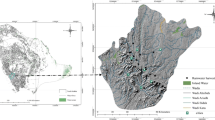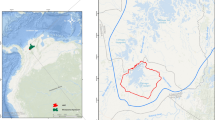Abstract—
The quantitative and qualitative study of wetland ecosystems is the main base for their sustainable use. In arid and semi-arid regions such as Iran, importance of wetlands is more obvious. Providing new information of changes in wetlands during several decades help us finding the reasons of alteration and making programs and policies. One of the most effective techniques in this field is remote sensing. Choghakhor international wetland, one of the most important wetlands in Iran. In this study, satellite images of MSS, TM, ETM +, and OLI were used during 1976–2017 to identify changes within the wetland. Also, the distribution of aquatic plants has been evaluated with NDVI index as an environmental indicator due to their key role on these aquatic ecosystems. After mapping the changes in wetland patterns over times, a cellular automata model (CA) was used to simulate changes up to the 2030s. The results of the time processing map data of the maps show the gradual decrease of the area (water body) of the wetland in the spring and more in the autumn season, which is more evident in recent years. However, the aquatic plants of the wetland in recent years has been. In general, three life periods for the Choghakhor wetland could be defined: “natural period”, “developmental period” and “dehydration period”. According to the CA model, the water body of the wetland shows a decreasing trend by 2030. On the other hand, aquatic plants growing in the wetland and its surroundings, which could be due to the high nutrient and organic load in future. Therefore, having an integrated strategy and program to improve the status of this unique ecosystem is necessary more than ever.







Similar content being viewed by others
REFERENCES
Alexandridis, T.K., Lazaridou, E., Tsirika, A., and Zalidis, G.C., Using Earth observation to update Natura 2000 habitat map for a wetland in Greece, J. Environ. Manage., 2009, vol. 90, no. 7, pp. 2243–2251.
Barbier, E.B., Acreman, M., and Krowler, D., Economic Valuation of Wetlands: A Guide for Policy Makers and Planners, Gland: Ramsar Conv. Bureau, 1997.
Behrouzirad, B., Wetlands of Iran, Tehran, 2007.
Boyle, C.A., Lavkulich, L., Schreier, H., and Kiss, E., Changes in land cover and subsequent effects on lower Fraser basin ecosystems from 1827 to 1990, Environ. Manage., 1997, vol. 21, no. 2, pp. 185–196.
Bwangoy, J.R.B., Hansen, M.C., Roy, D.P., DeGrandi, G., and Justice, C.O., Wetland mapping in the Congo Basin using optical and radar remotely sensed data and derived topographical indices, Remote Sens. Environ., 2010, vol. 114, pp. 73–86.
Chang, C.L. and Chang, J.C., Markov model and cellular automata for vegetation, J. Geophys. Res., 2006, vol. 45, pp. 45–57.
Chao Rodríguez, Y., Anjoumi, A., Domínguez Gómez, J. A, Rodríguez Pérez, D., and Rico, E., Using Landsat image time series to study a small water body in Northern Spain, Environ. Monit. Assess., 2014, vol. 186, pp. 3511–3522.
Choi, M. and Han, S., Remote sensing imageries for land cover and water quality dynamics on the west coast of Korea, Environ. Monit. Assess., 2013, vol. 185, no. 11, pp. 9111–9124.
Cui, L., Gao, C., Zhao, X., Ma, Q., Zhang, M., Li, W., Song, H., Wang, Y., Li, S., and Zhang, Y., Dynamics of the lakes in the middle and lower reaches of the Yangtze River basin, China, since late nineteenth century, Environ. Monit. Assess., 2013, vol. 185, pp. 4005–4018.
Domínguez Gómez, J.A., Alonso Alonso, C., and Alonso García, A., Remote sensing as a tool for monitoring water quality parameters for Mediterranean lakes of European Union water framework directive (WFD) and as a system of surveillance of cyanobacterial harmful algae blooms (SCyanoHABs), Environ. Monit. Assess., 2011, vol. 181, pp. 317–334.
Domotorfy, Z., Reeder, D., and Pomogyi, P., Changes in the macro-vegetation of the Kis–Balaton wetlands over the last two centuries: a GIS perspective, Hydrobiologia, 2003, vols. 506–509, pp. 671–679.
Ebrahimi, S. and Moshari, M., Evaluation of the Choghakhor Wetland Status with the Emphasis on Environmental Management Problems, Warsaw: Inst. Geophys., Pol. Acad. Sci., 2006.
Ehrenfeld, J.C., Evaluating wetlands within an urban context, Ecol Eng., 2000, 15:253–265.
Fanavaran Ab Sazeh (FAS) Consulting Engineers, Environmental Studies of Choghakhor Lake Basin, Detailed Studies of Choghakhor Lake, Tehran: Minist. Jihad Constr., 2004.
Hu, L., Hu, W., Deng, J., Li, Q., Gao, F., Zhu, J., and Han, T., Nutrient removal in wetlands with different macrophyte structures in eastern Lake Taihu, China, Ecol. Eng., 2010, vol. 36, pp. 1725–1732.
IPCC, Managing the Risks of Extreme Events and Disasters to Advance Climate Change Adaptation. Special Report of Working Groups I and II of the Intergovernmental Panel on Climate Change, Cambridge: Cambridge Univ. Press, 2012. http://ipcc-wg2.gov/SREX/images/uploads/ SREX-All_FINAL.pdf.
Jain, S., Siddiqui, A., Tiwari, P.S., and Shashi, M., Urban growth assessment using CA Markov model: a case study of Dehradun city, Proc. 9th Int. Geographic Union Conf. on Land Use Change, Climate Extremes, and Disaster Risk Reduction, Delhi, 2016.
Jensen, J.R., Rutchey, K., Koch, M.S., and Narumalani, S., Inland wetland change detection in the Everglades Water Conservation Area 2A using a time series of normalized remotely sensed data, Photogramm. Eng. Remote Sens., 1995, vol. 61, pp. 199–209.
Jin, X., Wan, L., Zhang, Y., Xue, Z., and Yin, Y., A study of the relationship between vegetation growth and groundwater in the Yinchuan Plain, Earth Sci. Front., 2007, vol. 14, no. 3, pp. 197–203. https://doi.org/10.1016/s1872-5791(07)60026-8
Jokar Arsanjani, J., Helbich, M., Kainz, W., and Darvishi, B.A., Integration of logistic regression and Markov chain models to simulate urban expansion, Int. J. Appl. Earth Obs. Geoinf., 2013, vol. 21, pp. 265–275.
Jokar Arsanjani, T., Javidan, R., Nazemosadat, M.J., Jokar Arsanjani, J., and Vaz, E., Spatiotemporal monitoring of Bakhtegan Lake’s area fluctuations and an exploration fits future status by applying a cellular automata model, Comput. Geosci., 2015, vol. 78, pp. 37–43
Kamusoko, C., Aniya, M., Adi, B., and Manjoro, M., Rural sustainability under threat in Zimbabwe-Simulation of future land use/cover changes in the Bindura district based on the Markov-cellular automata model, Appl. Geogr., 2009, vol. 29, no. 3, pp. 435–447.
Khattab, M.F.O. and Merkel, B.J., Application of Landsat 5 and Landsat 7 images data for water quality mapping in Mosul Dam Lake, Northern Iraq, Arab. J. Geosci., 2013, vol. 7, no. 9, pp. 3557–3573. https://doi.org/10.1007/s12517-013-1026-y
Kheirkhah Ghehi, N., Rahimi, L., and Malekmohammadi, B., Adaptive capacity building framework for wetland risk management in response to climate change, Proc. Int. Conf. “Water and Environment in the New Millennium: Education and Capacity Building,” Tehran, 2016.
Kulawardhana, R.W., Thenkabail, P.S., Masiyandima, M., Biradar, C.M., Vithanage, J.C., Finlayson, M., Gunasinghe, S., and Alankara, R., Evaluation of different methods for delineation of wetlands in Limpopo River basin using Landsat ETM+ and SRTM data, Proc. Int. Symp. “GlobWetland: Looking at Wetlands from Space,” Frascati, Italy, October 19–20,2006, Fernandez-Prieto, D. and Finlayson, C.M., Eds., Noordwijk: Eur. Space Agency, 2006, no. ESA SP-634.
Lazaridou, E., Zalidis, G., Papadimos, D., Billas, G., Takavakoglou, B., and Katsavouni, S., Study and Proposals for Restoring Cheimaditida and Zazari Wetlands, Thermi: Greek Biotope/Wetland Centre, 2001.
Likens, G.E., Biogeochemistry of a Forested Ecosystem, New York: Springer-Verlag, 2013.
Luo, J., Li, X., Ma, R., Li, F., Duan, H., Hu, W., Qin, B., and Huangc, W., Applying remote sensing techniques to monitoring seasonal and interannual changes of aquatic vegetation in Taihu Lake, China, Ecol. Indic., 2016, vol. 60, pp. 503–513.
Mansoori, J., National report, Proc. 11th Meeting of the Conference of the Contracting Parties (COP11), Bucharest, 2012.
McFeeters, S.K., The use of the Normalized Difference Water Index (NDWI) in the delineation of open water features, Int. J. Remote Sens., 1996, vol. 17, no. 7, pp. 1425–1432. https://doi.org/10.1080/01431169608948714
Middleton, B.A. and Kleinebecker, T., The effects of climate change induced drought and fresh water wetlands, in Global Change and the Function and Distribution of Wetlands, New York: Springer-Verlag, 2012.
Mitsch, W.J., and Gosselink, J.G., Wetlands, NJ: Wiley, 2007, 4th ed.
Papastergiadou, E.S., Retalis, A., Apostolakis, A., and Georgiadis, T., Environmental monitoring of spatio-temporal changes using remote sensing and GIS in a Mediterranean wetland of northern Greece, Water Resour. Manage., 2008, vol. 22, no. 5, pp. 579–594.
Pengra, B., The Drying of Iran’s Lake Urmia and its Environmental Consequences, Nairobi: UNEP Global Environ. Alert Serv., 2012.
Portal of the Meteorological Administration of Chaharmahal and Bakhtiari Province, 2017, http://www.chbmet.ir.
Tang, X., Huang, S., Scholz, M., and Li, J., Nutrient removal in pilot-scale constructed wetlands treating eutrophic river water: assessment of plants, intermittent artificial aeration and polyhedron hollow polypropylene balls, Water, Air Soil Pollut., 2009, vol. 197, pp. 61–73.
Tiner, R., Remotely-sensed indicators for monitoring the general condition of “natural habitat” in watersheds: an application for Delaware’s Nanticoke River watershed, Ecol Indic., 2004, vol. 4, pp. 227–243.
UNESCO, Convention on Wetlands of International Importance Especially as Waterfowl Habitat, Paris: UNESCO, 1994.
van Asselen, S., Verburg, P.H., Vermaat, J.E., and Janse, J.H., Drivers of wetland conversion: a global meta-analysis, PLoS One, 2013, vol. 8, no. 11, p. e81292. https://doi.org/10.1371/journal.pone.0081292
van Genderen, J.L., Lock, B.F., and Vass, P.A., Remote sensing: statistical testing of thematic map accuracy, Remote Sens. Environ., 1978, vol. 7, pp. 3–14.
von Neumann, J., The general and logical theory of automata, in Cerebral Mechanisms in Behavior: The Hixon Symposium, Jeffress, L.A., Ed., Chichester: Wiley, 1951, pp. 1–41.
Wetzel, R.G., Limnology: Lake and River Ecosystems, San Diego, CA: Academic, 2001, 3rd ed.
Wood, A., Dixon, A., and McCartney, M.P., People centered wetland management, in Wetland Management and Sustainable Livelihoods in Africa, Wood, A., Dixon, A., and McCartney, M.P., Eds., Oxon: Routledge, 2013.
Zarghami, M., Effective watershed management: case study of Urmia Lake, Iran, Lake Reservoir Manage., 2011, vol. 27, no. 1, pp. 87–94. https://doi.org/10.1080/07438141.2010.541327
Zhao, H., Cui, B., Zhang, H., Fan, X., Zhang, Z., and Lei, X., A landscape approach for wetland change detection (1979–2009) in the Pearl River Estuary, Procedia Environ. Sci., 2010, vol. 2, pp. 1265–1278.
ACKNOWLEDGMENTS
We thank Gorgan University of Agricultural Sciences and Natural Resources (GAU), Gorgan, Iran, for its support.
Author information
Authors and Affiliations
Corresponding author
Ethics declarations
Conflict of interest. The authors declare that they have no conflict of interest.
Statement of the welfare of animals. This article does not contain any studies involving animals or human participants performed by any of the authors.
Rights and permissions
About this article
Cite this article
Pirali Zefrehei Ahmad Reza, Aliakba, H., Saeid, P. et al. Detection and Prediction of Water Body and Aquatic Plants Cover Changes of Choghakhor International Wetland, Using Landsat Imagery and the Cellular Automata–Markov Model. Contemp. Probl. Ecol. 13, 545–555 (2020). https://doi.org/10.1134/S1995425520050091
Received:
Revised:
Accepted:
Published:
Issue Date:
DOI: https://doi.org/10.1134/S1995425520050091




